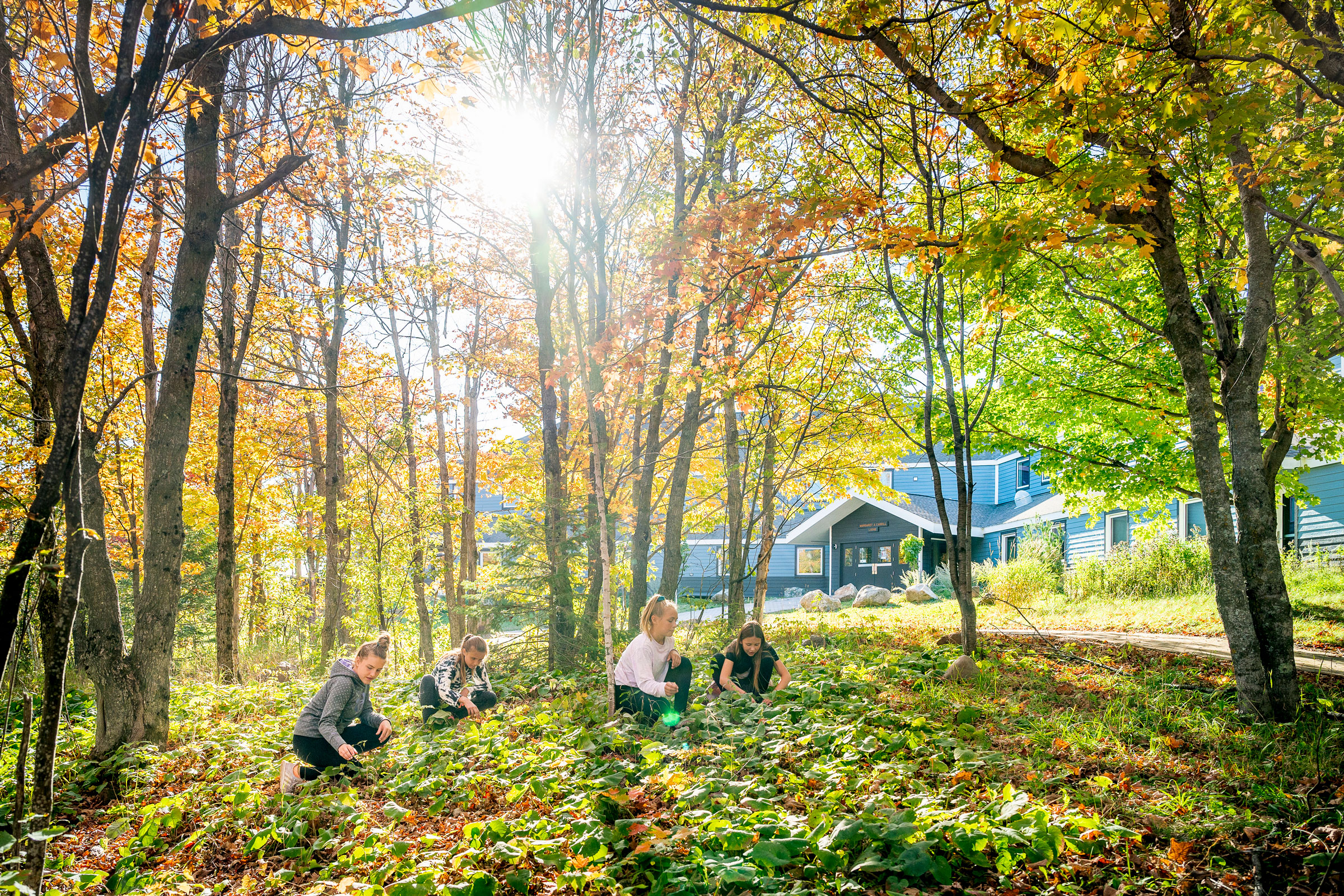Story at a glance:
- The Margaret A. Cargill (MAC) Lodge at Wolf Ridge Environmental Learning Center was designed by HGA.
- The center’s 2,000-acre campus is located on a ridge overlooking Lake Superior in Minnesota’s Northwoods.
- The lodge was designed around minimal disruption to the forest and emphasizing sustainable design principles.
How did a dormitory deep in Minnesota’s Northwoods become the first renovation project in the world to achieve Living Building Challenge (LBC) certification? When HGA’s integrated design and engineering team began working with Wolf Ridge Environmental Learning Center, the client’s mission of environmental conservation education was clearly aligned with the paradigm shift that the International Living Futures Institute aims to spark with the Living Building Challenge.
Environmental Conservation in the Northwoods
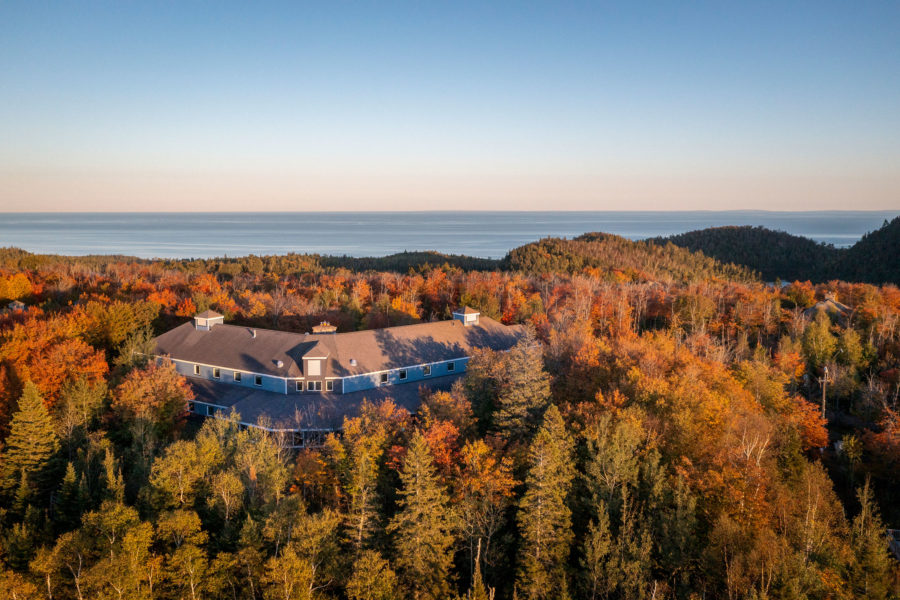
The MAC Lodge is nestled in the woods on a ridge that overlooks Lake Superior. Photo by Chad Holder, courtesy of HGA
On a ridge overlooking Lake Superior in northern Minnesota, Wolf Ridge Environmental Learning Center’s 2,000-acre campus features a river, creeks, two lakes, two high peaks, 18 miles of trail, and a mixed forest of maple, birch, and spruce.
Using the outdoors as a classroom, Wolf Ridge educators help visitors of all ages connect the beauty and wonder of the natural world with personal actions to foster conservationism. This mission also shapes the built environment on campus, bringing the outdoors in.
“We’re not just about looking at how we connect with nature, but about how we look at actions relative to our impact,” says Pete Smerud, executive director of the center. “We see buildings as part of the living, learning experience.”
Living Laboratory of Learning
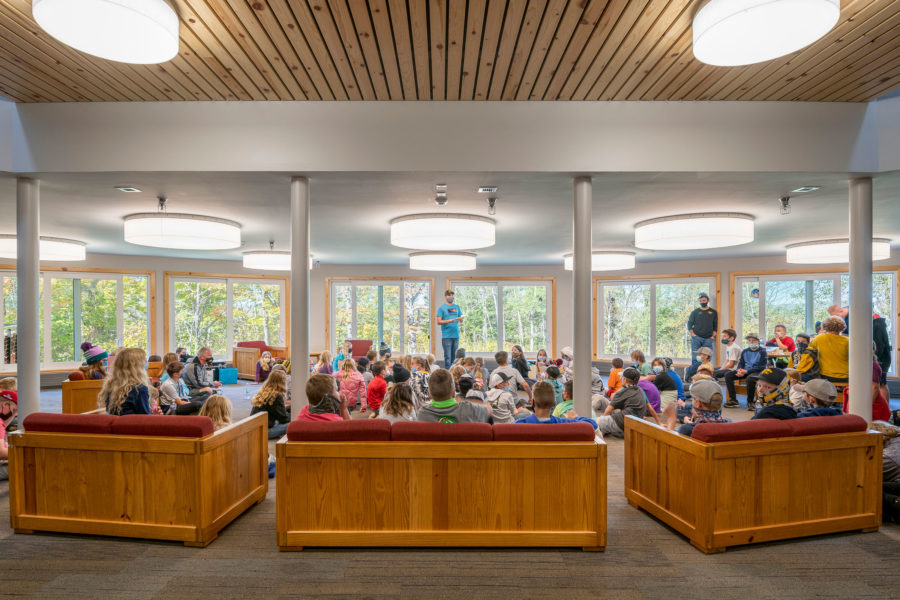
In the common room, students gather to discuss what they learned in their outdoor classes. Photo by Chad Holder
The design team had personal experience with visiting Wolf Ridge and believed in the opportunities this unique site offered for sustainable design. Those who grew up in Minnesota had fond memories of visiting as a child. Others had recent experience as chaperones for their children’s field trips.
And the Wolf Ridge Board of Directors wanted to raise the bar, challenging the design team to achieve the first LBC-certified project in Minnesota. The project scope included a complete remodel and expansion of the Margaret A. Cargill (MAC) Lodge and a new 7,800-square-foot staff building to house 24 graduate students teaching at Wolf Ridge. The two buildings aimed to create a home away from home for staff and guests and set a new precedent of regenerative design.
The building is a living laboratory of learning, where every basic function provides an educational opportunity for visitors. Achieving net zero energy and water becomes a learning experience via a monitoring and display system in each of the 25 resident rooms and the main lobby. Through a web-based platform and in-room monitors, guests are provided with domestic electrical energy, water, and heating energy budgets within which they must live.
With a water budget of six gallons per person per day, domestic electrical budget of 100W per person per day, and a heat energy budget, each room has an interactive screen providing real-time performance toward the net zero goals. In the lobby a large monitor provides room-by-room and overall building performance feedback toward achievement of net zero energy and water. Wolf Ridge staff meet daily with resident groups to review performance and help them understand choices and related consequences of behaviors.
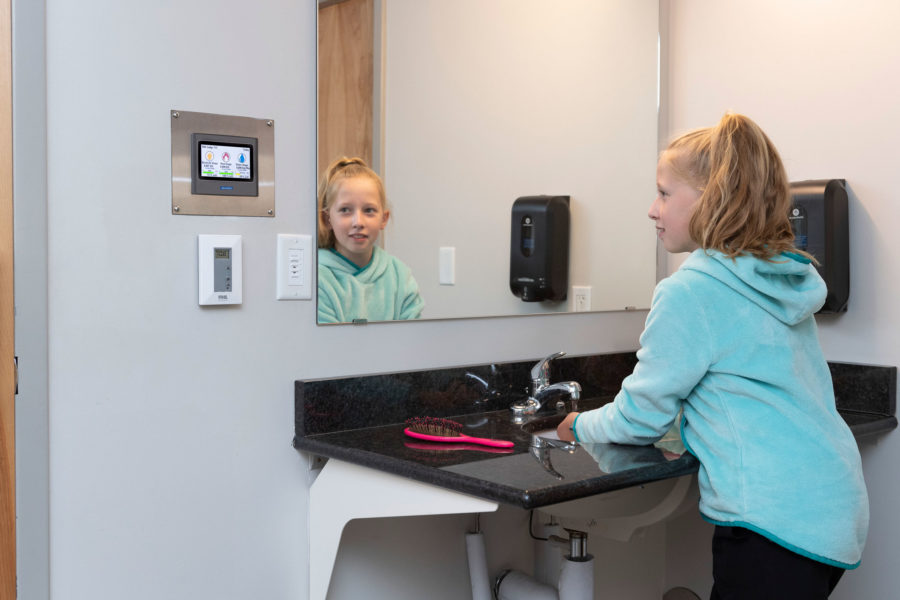
Resource use dashboard in a dorm room in the MAC Lodge. Photo by Chad Holder
Just as the building is now a living laboratory of learning for visitors, this project was a living laboratory of learning for the design and construction team. All parties involved—the owner, design team, contractor, subcontractors, manufacturers—were going through the LBC certification process for the first time, so the team used an iterative process to shorten feedback loops, maximize collective learning opportunities, and minimize time lost to the learning curve.
Before construction began the contractor and all subs came together for a two-day Living Building Challenge training where Wolf Ridge expressed why the certification was so important and aligned with their values. HGA introduced LBC’s seven “petals” to elevate the baseline of knowledge and establish a shared understanding of the project goals.
The staff building was designed to achieve LBC standards though was not registered for certification, serving as a pilot for the design team and contractor to test sourcing materials, work collaboratively, and uncover the challenges and barriers associated with LBC certification. With a construction schedule a year apart, the lessons learned from this pilot informed and improved the process for the MAC Lodge.
A Living Building Renovation
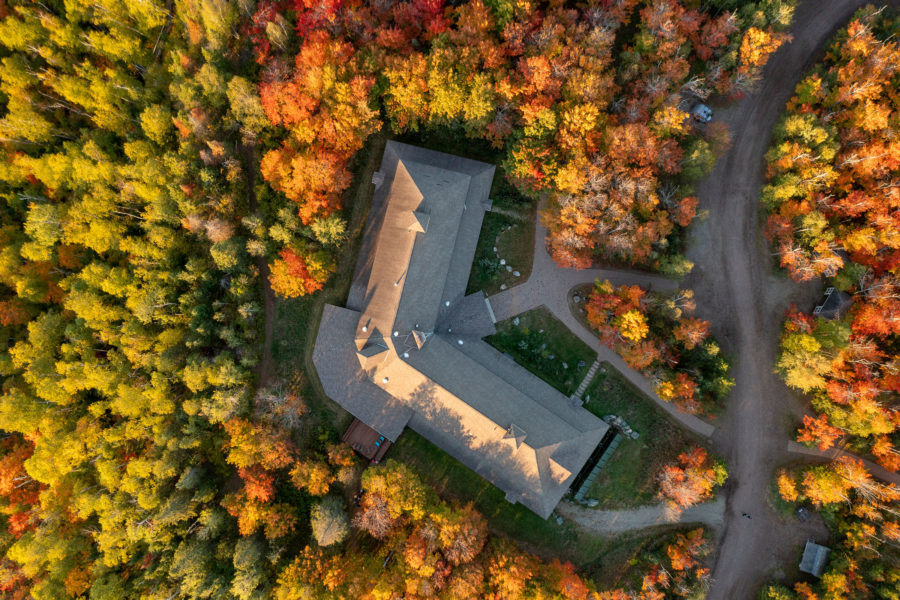
Construction for the MAC Lodge minimized the impact on the neighboring trees. Photo by Chad Holder
While most Living Building Challenge–certified projects around the globe are new construction, leveraging existing building stock plays an important role in minimizing carbon emissions. Early in schematic design, the architectural team worked with the owner to assess whether a new building would be necessary to meet the programming needs. Using a life cycle assessment, the team compared new construction and renovation scenarios to assess first costs, carbon impact, and operational costs, ultimately arriving at the decision to renovate, leveraging as much of the existing building as possible. The resulting gut and remodel maintained most of the building’s original shell and footprint, putting a new high-performance envelope on the existing frame.
Like the rest of the campus, the building is nestled among the trees and native plant growth—the natural geography closely abuts the built structures. Only four trees were removed during construction (to accommodate the eight dumpsters required for recycling), which were replaced with eight new climate-adaptive trees upon project completion.
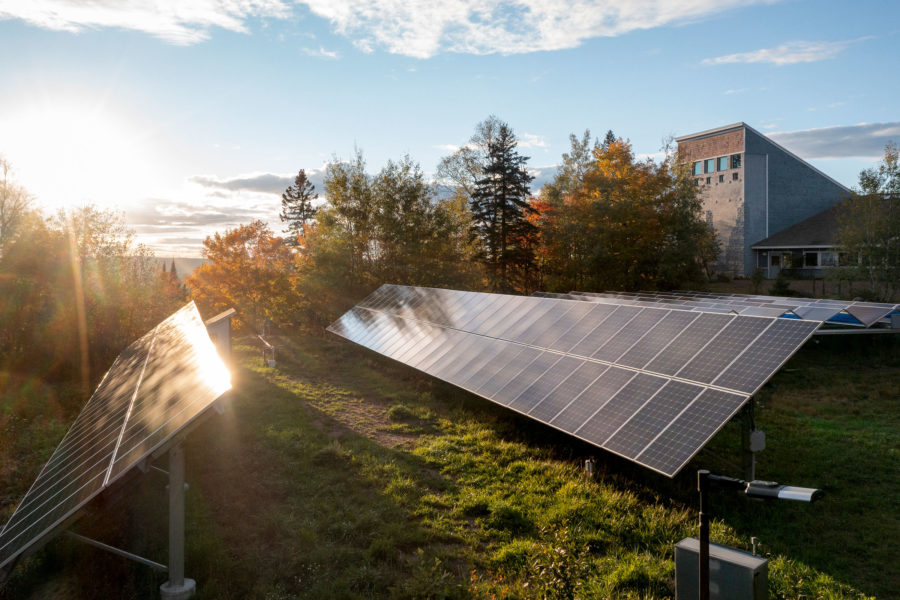
Solar field provides the MAC Lodge with renewable electricity. Photo by Chad Holder
In many ways, pursuing Living Building Challenge certification for this renovation did not change the design process as significantly as one might think. The architecture and engineering teams integrated energy conservation measures, allocating resources for the best return-on-investment. Materials specifications were guided by biophilic design concepts and what LBC calls Red List restrictions—the “worst in class” materials, chemicals, and elements known to pose serious risks. Wolf Ridge already produced food onsite, had clean potable water from a well, and treated all wastewater onsite. A solar field a few hundred yards from the building allowed the 40 kW solar PV array to be ground-mounted, providing a path to Net Zero Energy that did not require rooftop solar. At the end of the day, the project leveraged many simple design strategies that had a high impact.
Inspiring a Paradigm Shift
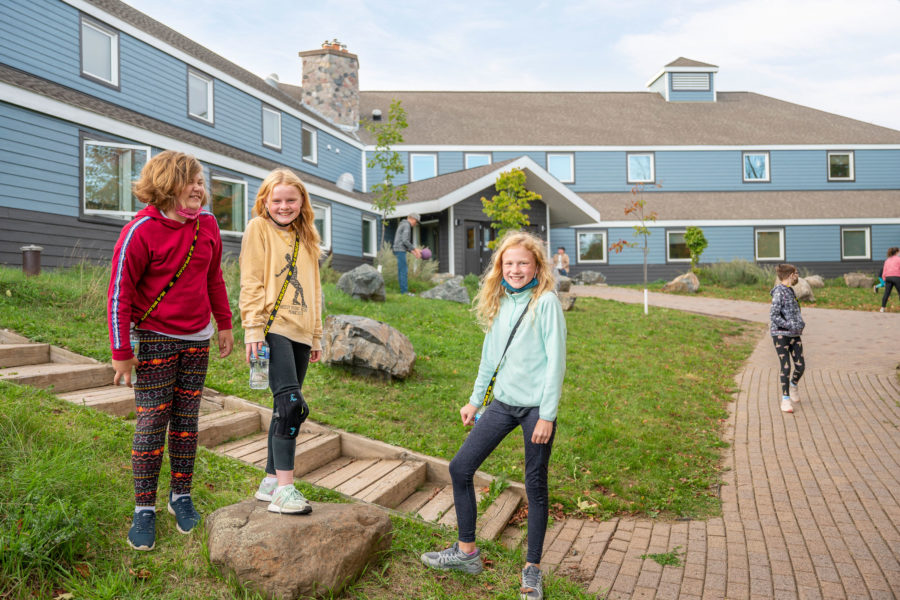
Students outside the MAC Lodge, which has 188 bedrooms, five communal gathering spaces, and 25 guest rooms. Photo by Chad Holder
Wolf Ridge Environmental Learning Center is a place where minds open to the joy and wonder of discovery of our natural world. The entire ethos of the organization is at work within the MAC lodge building, as it does not seek to disrupt the nature it sits within, but rather to become another teaching tool to help visitors understand their effect on the planet.
A deeply transformative project, these buildings are an integral part of the environmental learning process with visible, interactive sustainability features that help change attitudes and behaviors, inspiring the paradigm shift Wolf Ridge had hoped for.
The MAC Lodge at Wolf Ridge in the Northwoods of Minnesota demonstrates that renovation projects can achieve Living Building Challenge certification, dramatically raising the bar for owners, designers, and engineers to become better stewards of our land—because our future depends on it.
Project Credits
Project: Margaret A. Cargill Lodge at Wolf Ridge Environmental Learning Center
Location: Finland, MN
Size: 22,000 square feet
Architect: HGA
MEP Engineer: HGA
Lighting: HGA
Structural & Civil Engineer: HGA
Contractor: Gardner Builders
Landscape Design: HGA
Interior Design: HGA

